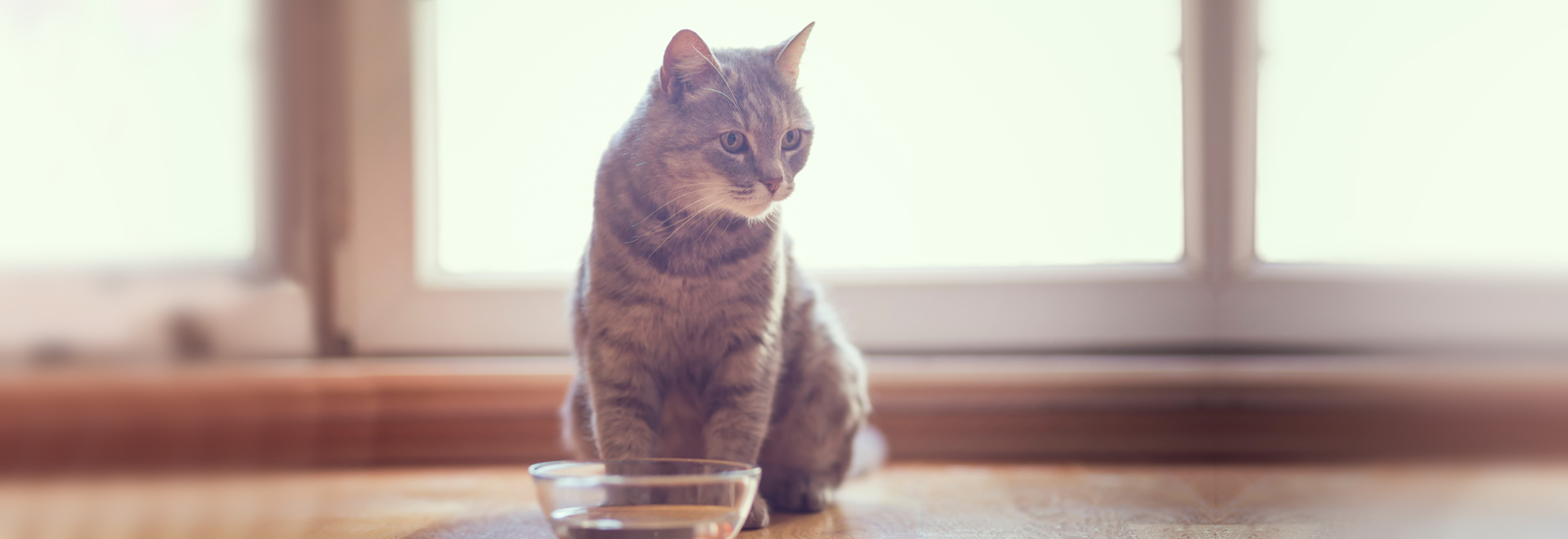Feeding cats with health conditions
They say that the way to someone’s heart is through their stomach. If your cat is ill, what it eats will also be of great importance, and in many cases cats with medical conditions can be helped with a suitable dietary food.
How can I tell if my cat is ill?
Cats are very good at hiding any illness. The reason for this is that an outdoor cat that is obviously ill is considerably more likely to be attacked and injured. This is why cats try not to let on that they are ill. This also applies to indoor cats, which is why even minor changes in behaviour, such as sleeping longer, are extremely important.
Some other examples could be: a dull or matted coat, or dry, flaky skin. Clear signs that a cat is ill are also changes in its eating or drinking behaviour. If your cat stops eating or is eating a lot more than usual but is losing weight at the same time, you should take it to a vet without delay. Changes in the consistency of its faeces, as in the case of diarrhoea or constipation, can also be signs of an illness. If the cat uses its litter tray more frequently or passes urine with traces of blood, this also indicates that the cat is ill.
Many medical conditions only involve inconspicuous symptoms at first. However, if you always keep a close eye on your cat, you have a good chance of discovering an ailment in good time so that you can get it treated by a vet while it is still at an early stage.
Regularly check your cat for any signs of an illness
It is best to regularly observe your cat and to take a systematic approach to what you see. If you check on your pet regularly, you will know it’s normal condition and be able to quickly recognise any changes.
What do I have to watch out for?
- What do the cat’s posture, coat and skin look like?
- How does the cat move around? (is it limping, and does it still jump on its scratching/climbing tree?)
- Are its ears, eyes, nose and mouth free of secretions and other deposits?
- Is there any reddening of the cat’s eyes?
- Are the pupils clear?
- Feel the cat’s neck, chest and abdomen and look for injuries, swellings, nodules on its skin or changes in its coat.
- Does your cat still let you rub its tummy? Or does it react by hissing?
- Check the anal and genital areas for redness, soreness and dirt.
If you check these points on a regular basis, you will soon get a feel for your cat and be able to provide your vet with valuable information in the event of illness.
The right food for cats with health conditions
The vet will take appropriate action to identify the cause of the illness based on the symptoms the cat shows when it is brought in. This may involve a blood and/or urine test, as well as X-rays or an ultrasound examination. Sometimes, however, just a quick glance allows the vet to spot, for example, that the cat is seriously overweight. Even if it is not perceived as aesthetically disturbing, the excess weight will have noticeable negative effects on the cat.
For cats with medical conditions, a special diet can result in a significant improvement in their health. animonda has developed INTEGRA PROTECT, a comprehensive range of dietary food for cats that can be used in cases of the following medical conditions:
- Chronic kidney disease
- Diabetes mellitus
- Urinary tract stones (struvite and oxalate stones)
- Acute diarrhoea (gastrointestinal problems)
- Food intolerance
![[Translate to English:] Katze isst Nassfutter](/fileadmin/media/images/Magazin/katze/02-Katzengesundheit/katze-kranke_katze_richtig_fuettern/katze-trinkt-magazin-kranke-katzen-richtig-fuettern-contentimage-560x375.jpg)
Cats with chronic kidney disease
The kidneys are vitally important organs that produce urine, which is used to remove waste from the body. The kidneys can develop acute and unfortunately also chronic disorders. Long-term (chronic) damage to the kidneys can be the result of, among other things, an infection, inflammation of the kidneys, or a tumour. Because the kidneys can compensate for their slow loss of tissue for a very long time, clear symptoms, such as increased drinking and greater urine output (accompanied by frequent visits to the litter tray), only become apparent when the illness reaches an advanced stage. If the cat is treated quickly, the symptoms will recede. Unfortunately, the lost kidney tissue will not regenerate. This is why early detection of this condition is so important and should be included in the annual check-up when cats reach a certain age. Chronic kidney disease is most common in older cats (7 years of age and older), so they should be seen regularly by a veterinarian for preventive examinations. The earlier kidney disease is diagnosed, the greater the chance that it can be treated effectively. Along with medical therapy, the cat should always be given special dietary food with a reduced protein and phosphorus content. With a special renal diet, cats with this condition can live to be very old.
Cats with a health condition: Diabetes mellitus
When the cat’s pancreas is no longer producing enough insulin, there is an increase in blood sugar, and the metabolism in the cells becomes unbalanced. The cat is diabetic. There are many possible reasons for this. Infections, the destruction of pancreatic cells, and obesity, for example, can lead to diabetes mellitus in cats.
This is particularly noticeable in the form of increased drinking and a higher volume of urine. If you suspect that your cat has diabetes, you should take it to a vet without delay to have its blood sugar level checked. Diabetes is treated by administering insulin, which has to be injected. In addition, the cat should be fed with a special high-protein food. Together, these will result in a decrease in the blood sugar level.
(Video) If diabetes is detected at an early stage and treated systematically, and if an obese cat loses weight, it is possible that the diabetes will disappear.
Urinary tract stones in cats
The lower urinary tract of cats is highly sensitive and can quickly contract an illness. Among the causes for this are urinary stones, especially struvite and calcium oxalate stones. Struvite stones in particular form when minerals (which are normally dissolved) build up in the urine. The cat owner should suspect a problem with the urinary tract if their cat goes to the toilet more often than usual, if it is noticeably unhappy, if it meows a lot, and if there is blood in its urine. The cat will be in a lot of pain, so a vet must be consulted as quickly as possible. After a diagnosis has been made and the type of stone determined, therapy geared to this stone type can start. Struvite stones are treated in a different way to calcium oxalate stones. Calcium oxalate stones usually have to be removed surgically, whereas struvite stones can be removed or broken up with ultrasound and special dietary food.
The use of a dietary food is recognised as a key cornerstone in the treatment and prevention of these types of urinary tract stones. An important characteristic of a dietary food for the prevention of struvite and calcium oxalate stones is a well-balanced mineral content. This content influences the pH value in the cat’s urine and varies in accordance with the type of stone. For struvite stones, the pH value should be lower than 6.5, while for calcium oxalate stones, it should be higher than 6.7. It is also important that the cat drinks enough. There should therefore be at least 2 water bowls per cat. A drinking fountain can also encourage your cat to drink.
Cats with severe diarrhoea
Sooner or later, every cat owner is confronted with the problem of their cat suffering from diarrhoea. This is not an illness, but a symptom that points to problems in the gastrointestinal tract. You should never underestimate diarrhoea, because it can cause the cat to lose a lot of fluids and minerals. If your pet’s condition does not improve within 24 hours, you should take it to a vet. In order to establish the cause of the diarrhoea as quickly as possible, the vet will want to know, among other things, whether the cat has been dewormed, what food you are giving it, how long it has had diarrhoea and what the consistency of its faeces is like. If the cat’s general condition has not been further affected, it is advisable to not give the cat any food for one day. You should, however, give it small amounts of water throughout the day. If the diarrhoea has disappeared after 24 hours, you should give your pet some light food that is gentle on the stomach. Above all, it should contain easy-to-digest animal proteins and only a small amount of dietary fibre.
Food intolerance in cats
When a cat has a food intolerance, its immune system reacts very severely to proteins in its food. This condition can appear practically overnight. Now it is important to find out what protein is causing the allergy. The diagnosis is therefore always carried out on the basis of an exclusion diet. For this purpose, a food with one animal and one vegetable protein should be chosen with which the cat has never before had any contact or at least only to a minimal extent.
This diet, specially tailored to the cat, should lead to the disappearance of the symptoms. Special dietary foods are available for this purpose with just one source of animal protein that must be indicated on the product.
Sadly, for an exclusion diet to be successful, the cat is not allowed to have any snacks or treats.
You may also like this
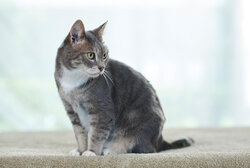
Food allergies in cats
In the case of a food allergy, a special food can help
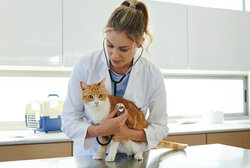
Kidney problems in cats
If its urine shows abnormalities, your cat should be examined
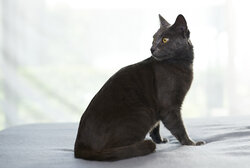
Diabetes in cats
Cats too can suffer from elevated blood sugar levels
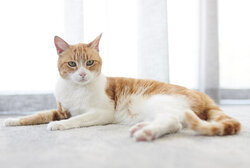
Diarrhoea in cats
Immediate measures and dietary changes in cases of diarrhoea
